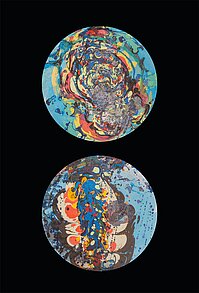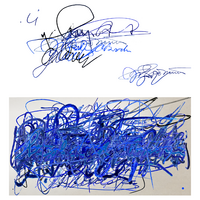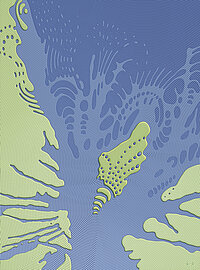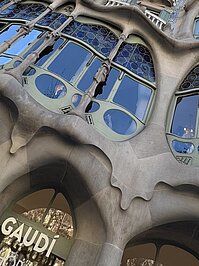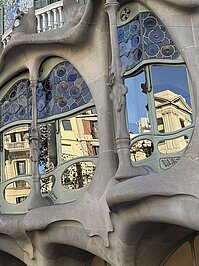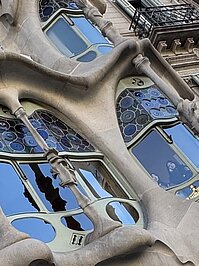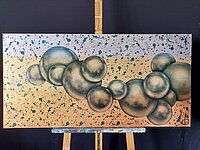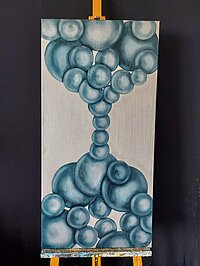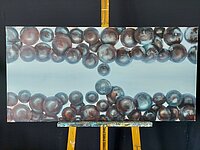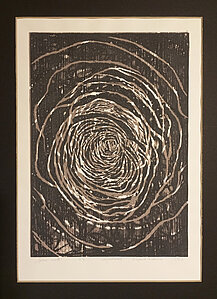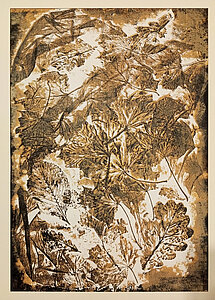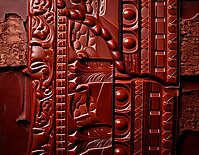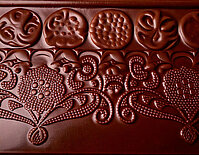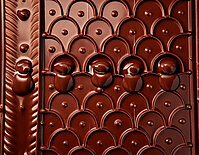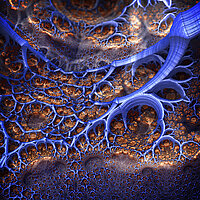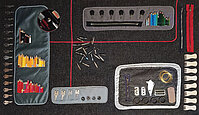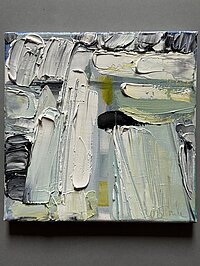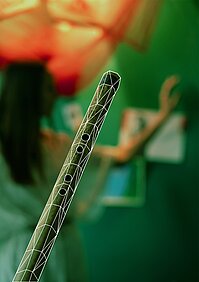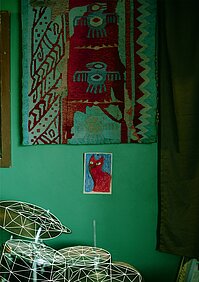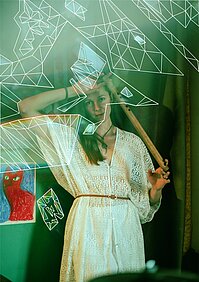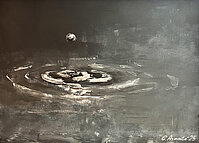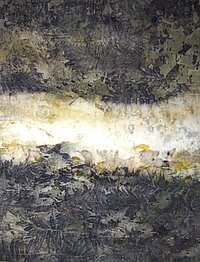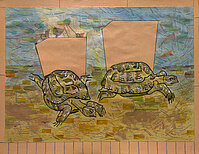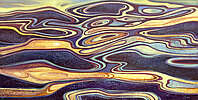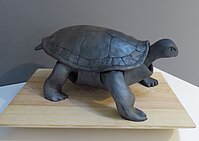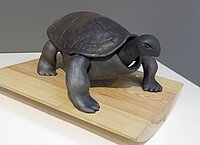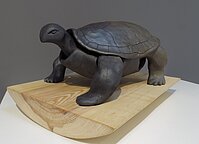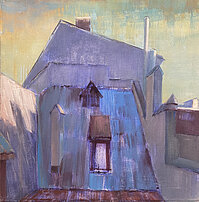Latvijas Universitātes 83. starptautiskās zinātniskās konferences sekcijas MĀKSLA. DIZAINS. TEHNOLOĢIJAS. IZGLĪTĪBA ietvaros no 2025. gada 5. februāra skatāma kārtējā mākslas darbu izstāde, kuras kopsaucējs šajā reizē ir VIRSMA.
Virsma ir viss. Virsmas īpatnība kā objekta vai subjekta ārējā veidola raksturojums tiek lietots gandrīz visās zinātņu nozarēs. Virsma ir ikvienas lietas, dzīvas radības, materiāla vai vides specifiska, ieraugāma, sataustāma un sajūtama īpašība. Tās raksturošanai lietojam terminu tekstūra. Tomēr virsmas jeb ārējās tekstūras iespaids var būt maldinošs un bieži vien ļoti atšķirīgs no iekšējās tekstūras. Mākslas darbos visbiežāk notiek tieši ārējo, dabisko virsmas īpašību atdarināšana, rezultātā iegūstot unikālu faktūru. Tēlnieki Mikelandželo Buanaroti un Džovanni Lorenco Bernīni, apstrādājot marmora virsmu, panāca gan dzīvas miesas vizuālu ilūziju, gan smaga auduma raupjuma efektu. Tam viņiem nevajadzēja mīkstu vai krāsainu materiālu, viss notika vienkrāsainā, diezgan graudainā materiālā. Gleznotājs Jans van Eiks darīja visu, lai uz koka pamatnes gleznotās ainas būtu spožas, krāsainas un to virsmas absolūti gludas. Tas netraucēja radīt vizuālu ilūziju par īstu samtu, vilnu, stiklu, bronzu, koku un daudziem citiem materiāliem. Tāpat tas notiek ar Anselma Kīfera mākslas darbiem, kuros dabas materiālu unikālās tekstūras kolāžās kļūst par simboliskām, apslēpto saturu vēstošām faktūrām. Savukārt vairāki impresionisti par virsmu nerūpējās it nemaz. Tuvumā apskatot, mākslas darbu virsmas ir kā triepienu plūsma, neatkarīgi no tā, vai attēlotas debesis vai pļava. Izstādē VIRSMA piedalās Latvijas Universitātes docētāji un kolēģi no Daugavpils Universitātes, Rēzeknes Tehnoloģiju akadēmijas un RTU Liepājas akadēmijas. Ieskatoties katrā darbā, virsmu daudzveidību varam izbaudīt visdažādākajās izpausmēs. Pārsteidz gan materiālu, gan motīvu, gan paņēmienu izvēle. Spēcīgu emocionālo vēstījumu rada reālistiski, abstrakti un simboliski darbi. Tie ir gan tradicionālās, gan digitālās, gan īpašās autortehnikās veidoti. Lai raksturotu šos mākslas darbus, katram darbam iespējams piemērot kādu raksturojošu vārdu: atspulgs, dabīgs, dalījums, dziļums, forma, gaisma, gardums, ideāls, izaicinājums, laukums, līdzsvars, mainīgs, materiāls, mānīgs, mirdzums, mīkstums, neredzamais, plūdums, spīdums, spogulis, spožums, stikls, viļņojošs, zīds. Un, protams, daudzus citus. Vārdi, kas raksturo izstādes VIRSMA mākslas darbus, raisa plašu taktilo sajūtu un emociju spektru. Kurš vārds kuram darbam vislabāk atbilst – lai lemj skatītājs. Austra Avotiņa | Within the framework of the 83rd International Scientific Conference of the University of Latvia, the ART. DESIGN. TECHNOLOGY. EDUCATION section, the next exhibition of artworks will be on view from February 5, 2025, the common denominator of which this time is SURFACE. The surface is everything. The characteristic of the surface as a description of the external form of an object or subject is used in almost all fields of science. Surface is a specific, visible, tangible and sensible property of any thing, living creature, material or environment. We use the term texture to describe it. However, the impression of surface or external texture can be misleading and is often very different from the internal texture. In artworks, it is most often the imitation of the external, natural surface properties that results in a unique texture. Sculptors Michelangelo Buonarroti and Giovanni Lorenzo Bernini worked the marble surface to achieve the visual illusion of living flesh and the roughness of heavy fabric. They did not need a soft or coloured material; everything was done in a monochrome, rather grainy material. The painter Jan van Eyck ensured that the scenes painted on the wooden base were bright and colourful and the surfaces smooth. This did not prevent the visual illusion of real velvet, wool, glass, bronze, wood and many other materials. The same is true of Anselm Kiefer’s artworks, in which the unique textures of natural materials in collages become symbolic textures that convey hidden content. On the other hand, several Impressionists did not care about the surface. On close inspection, the surfaces of their works of art are like a flow of brushstrokes, whether they depict the sky or a meadow. The exhibition SURFACE brings together lecturers from the University of Latvia and colleagues from Daugavpils University, Rēzekne Academy of Technologies and RTU Liepāja Academy. Looking at each work, we can enjoy the diversity of surfaces in their various manifestations. The choice of materials, motifs and techniques is surprising. Realistic, abstract and symbolic works create a strong emotional message. They are made using traditional, digital and special techniques. Each work can be given a descriptive word to explain it: reflection, natural, division, depth, shape, light, delicious, perfect, challenging, square, balance, variable, material, insidious, shimmer, soft, invisible, flow, shine, mirror, glow, glass, rippling, silk. And of course many others. The words describing the artworks in SURFACE evoke many tactile feelings and emotions. Which word best suits which work – let the viewer decide. Austra Avotina |
Izstāde skatāma arī Latvijas Universitātes Izglītības zinātņu un psiholoģijas fakultātes telpās - Izglītības zinātņu un psiholoģijas bibliotēkā.
Diāna Apele (RTA). VIRSMU SASPĒLE / SURFACE INTERPLAY
Šodien ir svarīgi noturēt līdzsvaru starp tiešsaistes un bezsaistes dzīvesveidu. Cilvēks ir apreibis no iespēju pārpilnības un neskaitāmo izvēļu nastas – ir bailes apstāties un palēnināt tempu. Z. Rubene grāmatā “Digitālā bērnība” izsakās, ka tieši mūsu digitālo tehnoloģiju izmantošanas paradumi ir tie, kas samazina laimes izjūtu, novirza uzmanību no vērtīgām aktivitātēm… Var runāt par daudz un dažādām jēgpilnām nodarbēm. Viena no tām noteikti ir MĀKSLA. Māksla ir arī viens no astoņiem apbrīnu izraisošiem dzīves brīnumiem. Šie visi astoņi brīnumi mums ir visapkārt, ja vien apstājamies uz mirkli un atveram prātu.
Mākslas darba VIRSMU SASPĒLE koncepts ir savijies ar dzīves mākslas kontekstu šodien, kur tiek ieteikts tvert mirkli, uzsākt savu paradumu maiņu un jēgpilnu dzīves vadīšanu jau tagad. Spēlēsimies/mākslosimies! …un māksla izglābs pasauli! (Pārdomas pēc grāmatu “Digitālā bērnība” (Z. Rubene) un “Apbrīna” (D. Keltners) izlasīšanas.)
Today it is important to maintain a balance between online and offline lifestyles. People are intoxicated by the abundance of opportunities and the burden of countless choices – they are afraid to stop and slow down. Z. Rubene in her book “Digital Childhood” states that our habits of using digital technologies reduce the feeling of happiness, and divert attention from valuable activities. We can talk about many and various meaningful activities… one of them is ART. Art is also one of the eight awe-inspiring miracles of life. All these eight miracles are around us if only we stop and open our minds for a moment.
The concept of the artwork SURFACE INTERPLAY is intertwined with the context of the art of living today, where it is recommended to capture the moment, start changing our habits and lead a meaningful life right now. Let's get creative! …and art will save the world! (Reflections after reading the book “Digital Childhood” (Z. Rubene) and “Awe” (D. Keltners)).
Solvita Zariņa (LU). ZĪMJU ORĶESTRIS / ORCHESTRA OF SIGNS
Mākslas darbs atklāj ar roku rakstītu parakstu vizuālo spēku un informācijas piesātinājumu. Mazākā vienība šeit ir viena paraksta attēls, kas izņemts no parakstītā dokumenta varas, vienošanās un “laika zīmoga” konteksta, reflektējot par tā estētiskās vērtības potenciālu. Paraksti tiek kontekstualizēti kā attēlu grupu ansambļa “dalībnieki” un tie kā mākslas darba sastāvdaļas veido simbolisku zīmju “orķestri”, radot meta-komunikācijas līmeni.
“Zīmju orķestra” vizuālā komunikācija ir apzināti daudzveidīga, sākot no dekoratīvas līniju kompozīcijas līdz ekspresīvam un pārsātinātam vizuālajam troksnim. Līnijas žesta spēks, izteiksmīgums, kā arī vizuālās rakstības pārsvars pār salasāmību šeit ir saistīts ar autores izvirzītu konceptuālu uzstādījumu par parakstu kā “vernakulārās kaligrāfijas” formu.
Darbs ir parakstīts ar autores “personīgo zīmogu”. Tas norāda uz darba autorību un vienlaikus paliek anonīms, jo “zīmogam” ir vienkārša apļveida ģeometriska forma bez nolasāmas tekstuālas informācijas.
This artwork explores the information saturation and visual power of handwritten signatures by using a single signature image as the smallest unit to form image clusters. The signatures are removed from the context of power, agreement and “timestamp”, recalling their aesthetic value and expressiveness. The signatures form an “orchestra” of symbolic signs that generates meta-communication.
The visual communication of the ORCHESTRA OF SIGNS is deliberately diverse, ranging from a decorative linear composition to an oversaturated and intense visual noise. The expressive power of the gesture and the predominance of visual writing over legibility are related here to the author’s conceptual premise of signatures as a form of “vernacular calligraphy”.
The artwork is signed with the author’s “Personal Seal". It stands for the authorship of the work and at the same time remains anonymous, as it has a simple geometric shape with no legible information.
Zeltīte Barševska, Arvīds Barševskis (DU). Triptihs GAUDI. FLIRTS / Triptych GAUDI. FLIRT
Flirts ar virsmām un formām. Flirts ar krāsu atspulgiem un ēnām. Flirts ar siltiem un aukstiem toņiem. Flirts ar vēsturi un mūsdienām. Fotogrāfa flirts ar GAUDI.
Flirting with surfaces and shapes. Flirting with colour reflections and shadows. Flirting with warm and cold tones. Flirting with history and the present. The photographer’s flirting with GAUDI.
Gunta Krastiņa (RTU Liepājas akadēmija). Darbi no cikla INTUĪCIJA / Works from the INTUITION series
LAIKS
BEZGALĪBA
JAUNS SĀKUMS
Redzamie darbi ir no lielāka cikla INTUĪCIJA (kopā 10 darbi), kas tapis 2022. gada sākumā. Pēdējie tika pabeigti pirms 24. februāra… Laikā, kad norisinājās notikumi, kurus cilvēks nav spējis ne paredzēt, ne ietekmēt… Tātad darbi tādā vai citādā veidā vēsta par nākotni. Darbi LAIKS, BEZGALĪBA un JAUNS SĀKUMS spilgti atspoguļo šī laika norises – nekas nav beidzies un visa pamatā ir laiks un cerība uz jaunu sākumu.
TIME
ENDLESSNESS
NEW BEGINNING
The three-part work INTUITION is part of a larger exhibition that consists of 10 works in total. These works were created in early 2022 when unspeakable things happened in the world that the average person could not have predicted or impacted. The last work in this exhibition was finished before February 24. In many ways, these works reflect the hopes for a future, as the titles TIME, ENDLESSNESS, and NEW BEGINNING show that nothing has ended yet and that time and hope for a future is the thing at the root of everything.
Gita Līpenīte (RTA). SPĒKA AVOTS / SOURCE OF STRENGTH
Virmojoša ūdens virsma, koncentriski apļi izplešas un pamazām izgaist… Bet kas ir tur – dziļumā, noslēpumainajā tumsā? Tas citiem nav zināms, tas paliek apslēpts. Katram savs – spēka avots.
Darbu iedvesmoja cilvēki man apkārt. Es ikdienā paskrienu garām daudziem, nedaudzus satieku, ar dažiem aprunājos un šad tad kādā ielūkojos dziļāk, varbūt pavisam nejauši, nedroši, tomēr intuitīvi jūtot – tur kaut kas ir, atbalsojas, atspīd, rezonē, iznāk virspusē un bagātina mani pašu, kļūst par manu spēka avotu
A swirling surface of water, concentric circles expanding and gradually disappearing… But what is there – in the depths, in the mysterious darkness? Unknown to others, it remains hidden. To each their own – a source of strength.
The people around me inspired this work. I pass by many people every day, meet a few, and talk to a couple. Sometimes, I look deeper into one, perhaps by chance, uncertainly, but intuitively feeling that something is in there, echoing, reflecting, resonating, coming to the surface and enriching me, becoming my source of strength.
RUDENS PĒDAS / FOOTPRINTS OF AUTUMN
Rudens īstais, kas nāk pēc “zelta rudens” – īsa, saulaina prieka mirkļa, – auksts, vējains, lietains, un lapas – visur tās nobirušās lapas, sētnieku sejās smaidu nemana, darba daudz! Bet man un viņam tās ir skaistas, tās čaukst, lido un krīt, lietū salīp kopā, veidojot savus brīvos ritmus, akcentus, dominantes, harmonijas, kompozīcijas…
Uz asfalta, zālājā un domās paliek rudens pēdas.
The real autumn, after the “golden autumn” – a short, sunny moment of joy, is cold, windy, and rainy. Leaves – dead leaves everywhere, no smile on the faces of the sweepers, lots of work! But they are beautiful to me and him, they rustle, fly, and fall, they stick together in the rain, forming their free rhythms, accents, dominants, harmonies, compositions…
On the asphalt, on the lawn and in my thoughts, traces of autumn remain.
Agris Dzilna (LU). Kolekcija SUVENĪRI / Collection SOUVENIRS
BARSELONA
TUNISA
VENĒCIJA
Atgriežoties no svešām zemēm, parasti mājās palicējiem tiek vesti suvenīri. Nereti tie ir saldumi, starp kuriem īpašu vietu ieņem svešo zemju šokolāde.
Šī ir mana interpretācija par šiem saldajiem suvenīriem.
BARCELONA
TUNIS
VENICE
Returning from foreign lands, souvenirs are usually brought back for those who stayed at home. Often, these are sweets, among which foreign chocolate holds a special place.
This is my interpretation of these sweet souvenirs.
Aldis Kopštāls (LU). DAĻA NO NEZINĀMĀ / PART OF THE UNKNOWN
Visumu aptverošajam piemīt fraktālā daba. Jebkurā esībā mēs varam saskatīt jaušākas vai nejaušākas likumsakarības un atkārtojamību. Pētot virsmas struktūras, ātri vien atskārstam slēptas matemātikas pamatus. Viens no 3D modelēšanas veidiem ir fraktālā vizualizācija, kurā, slēpjoties matemātiskās formulās, atklājas dabas nebeidzamā daudzveidība.
The universe is fractal. We can see more or less random regularities and repetitiveness in any entity. When we study surface structures, we quickly uncover hidden mathematics. One form of 3D modelling is fractal visualisation, which reveals the infinite variety of nature hidden in mathematical formulae.
Austra Celmiņa-Ķeirāne (LU). DARBVIRSMA / DESKTOP
Darbvirsmu var organizēt un sajaukt, loģiski kārtot vai haotiski piemētāt, un tā ir katra paša izvēle. Galvenais, lai tā ir ērta un neviens cits tajā nejauktos.
The desktop can be organised or messy, logical or chaotic, and that's up to the individual. The main thing is that it is comfortable and no one else messes in it.
Ingrīda Irbe (LU). BEZ NOSAUKUMA / UNTITLED
Dialogs ar audeklu sākas ar paletes naža nospiedumiem uz gleznas virsmas. Biezās, raupjās un gludās, izplūdušās un asās faktūras, vertikālie un horizontālie triepieni izveido daudzslāņainu virsmu. Tā ir intuitīva pieeja, kas ļauj radīt kompozīciju ar savu strukturēto kārtību.
Gleznas virsma šeit rada vizuālu ilūziju, ko abstraktā darbā katrs var brīvi interpretēt.
The dialogue with the canvas begins with the impressions of the palette knife on the surface of the painting. Thick, rough and smooth, blurred and sharp textures, vertical and horizontal strokes create a multi-layered surface. This intuitive approach allows you to create a composition with its structured order.
The surface of the painting here creates a visual illusion that everyone can freely interpret in an abstract work.
Natālija Brokāne (RTA). Darbu sērija MUZIKĀLO VIRSMU MIJIEDARBĪBA / Series INTERACTION OF THE MUSICAL SURFACES
MUZIKĀLĀ VIRSMA
STARP MUZIKANTU UN VIRSMU
MUZIKANTA DVĒSELES VIRSMA
Darbu iecere balstās uz pārdomām par virsmas būtību kā ģeometrisku divdimensionālu varietāti starp muzikantu, muzikāliem instrumentiem un pašu skaņdarbu. Ja instrumentiem var viegli saskatīt līniju trajektorijas ar aci, tad mākslinieks spēj saskatīt skaņdarba virsmu ar aizvērtām acīm, saklausot to sirdī…
MUSICAL SURFACE
BETWEEN THE MUSICIAN AND THE SURFACE
THE MUSICIAN'S SOUL SURFACE
The concept of the works is based on reflections on the essence of the surface, which is a geometric two-dimensional variety between the musician, musical instruments, and the composition itself. While one can easily see the trajectory of lines in the instruments with the eyes, the artist can perceive the surface of the composition with closed eyes, hearing it in the heart.
Gaļina Asmaite (LU). PĒDAS UZ VIRSMAS / MOVEMENT ON THE SURFACE
Katra darbība vai kustība atstāj pēdas…
Katrs vārds, doma vai rīcība izjauc ierasto kārtību un ietekmē turpmāko notikumu gaitu.
Every action or movement leaves a trace…
Every word, thought, or deed disrupts the established order and influences the course of future events.
Rita Broka (LU). AINAVAS VIRSMA / SURFACE OF THE LANDSCAPE
Krāsojot ar augiem, veidojas īpašas attiecības ar vietu, tajā mītošo veģetāciju, tajā pulsējošajiem iekšējo dzīvības spēku ritmiem, kustību, sākumu, plaukumu un kaili pelēko pamirumu. Ar laiku šo attiecību iespaidā izveidojas savdabīga apkārtnes uztveres mentālā karte, kur domu līkumojošie ceļi aizved pa tikai sev vien zināmām vietām, iezīmējot neredzamu, citkārt nenojaušamu koku, krūmu un ziedu sabiedrības tīmekli, taustāmi izjūtamu sajūtu un atmiņu ainavas virsmu.
Dyeing with plants creates a special relationship to the place, to the vegetation that inhabits it, to the rhythms of the inner life forces pulsating there, to movement, to the beginning, to blossoming and to bare, grey decay. Over time, under the influence of these relationships, a peculiar mental map of the perception of the environment is formed, in which the winding paths of thought lead to places known only to oneself, marking an invisible, otherwise unsuspected network of trees, bushes and flowers, a tangible landscape surface of feelings and memories.
Nikifs (LU). BRUŅU MĀJIŅAS / ARMOURED HOUSES
Darbā virsma izcelta kā aizsardzības un mājvietas simbols. Bruņurupuču čaulas savā būtībā ir virsmas, kas aizsargā dzīvības kodolu, tā veidojot robežu starp iekšējo un ārējo pasauli.
Vienkrāsainu papīru silueti kontrastē ar līnijām un teksturētiem triepieniem, lai radītu dinamisku virsmas efektu, uzsverot tās daudzslāņainību un nozīmi gan dabā, gan mākslā.
The artwork highlights the surface as a symbol of protection and home. The turtle shells inherently represent surfaces that safeguard the essence of life, forming a boundary between the inner and outer worlds.
The silhouettes of plain-coloured paper contrast with textured strokes and dynamic lines to create a vibrant surface effect, emphasising its multi-layered nature and significance in nature and art.
Inese Dundure (RTA). RĪTAROSME / MORNING EXERCISES
Keramikas objekts veidots no šamota un apdedzināts Latgales bedres tipa atklātas uguns keramikas apdedzināšanas ceplī. Tā virsmas apdarē redzamas gan pirkstu, gan koka instrumentu pēdas, gan pulējums ar akmeni.
Objekta ideja: Transformētas sajūtas, kas pārņem rītā, kad prāts un ķermenis līdzinās lielam un mazkustīgam bruņurupucim un pamazām iešūpojas dienas darbiem.
The ceramic object is made of chamotte and fired in a Latgale pit-type open-fire ceramic kiln. Its surface finish shows traces of fingers, wooden tools, and stone polishing.
Object idea: Transformed feelings that take over in the morning, when the mind and body resemble a large and slow turtle and gradually sway to the day’s work.
Agata Muze (LU). JUMTI / ROOFS
Pēdējo gadu laikā daudz esmu gleznojusi koku motīvus, priecājoties par zaru un stumbru liekumiem, pinumiem un ritmiem, kuri ir nebeidzams iedvesmas avots. Bet pavisam nesen esmu sākusi ieraudzīt kā sev sirdij tuvus arī pilsētas motīvus. Jo sevišķi daudzpakāpju ritmi, līnijas un dažādas virsmu faktūras vecpilsētu jumtu skatos šobrīd šķiet īpašas uzmanības vērtas.
Over the last few years, I have been painting a lot of tree motifs, enjoying the curves, braids and rhythms of branches and trunks, which are a never-ending source of inspiration. But more recently I have begun to see urban motifs as close to my heart. In particular, the layered rhythms, lines, and different surface textures on the old town roofs seem particularly worthy of attention now.

 CONFERENCE
CONFERENCE